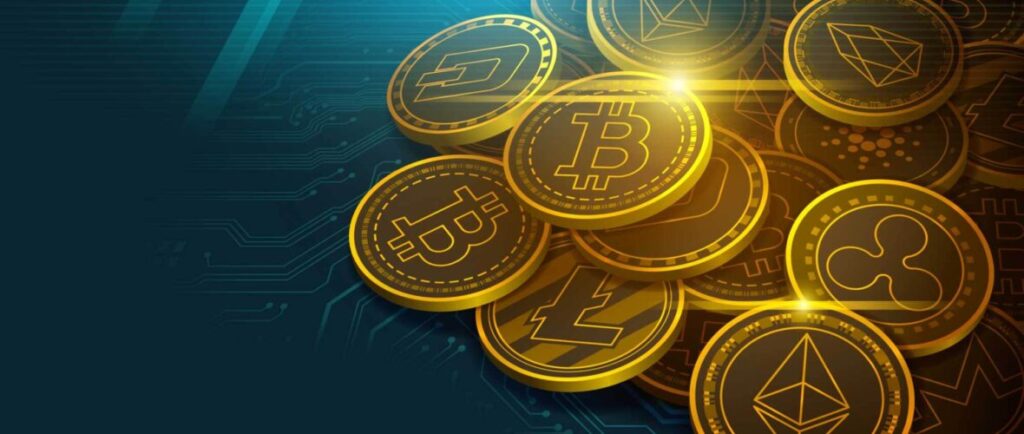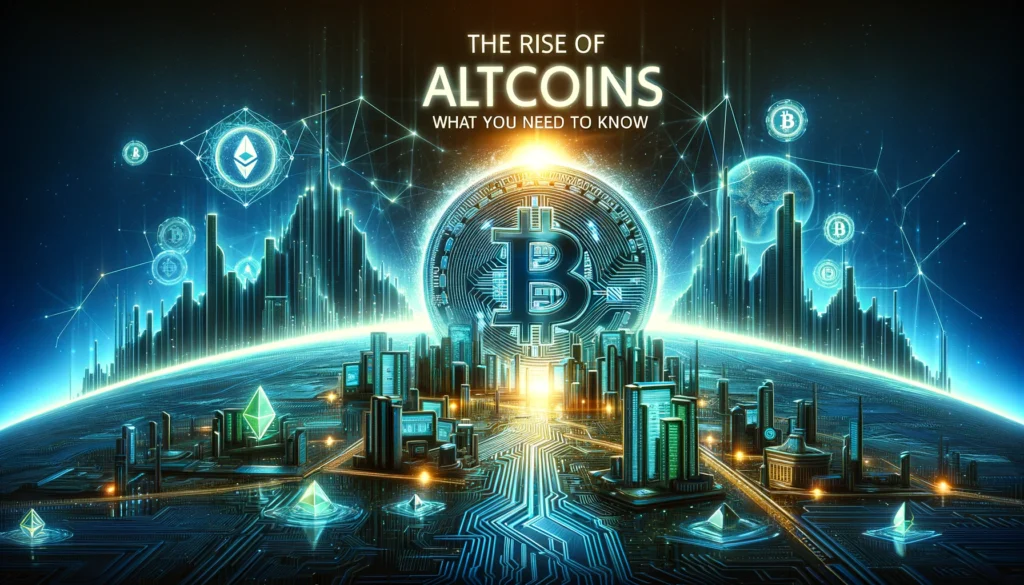In the world of digital finance, The Rise of Altcoins marks a pivotal shift, heralding a new era of innovation and opportunity. Altcoins, or ‘alternative coins’, have risen from the shadows of Bitcoin, offering diverse functionalities, enhanced features, and distinct technological advancements. This comprehensive guide delves into the fascinating journey of altcoins, shedding light on their origins, technological innovations, and the impact they wield in the sprawling landscape of cryptocurrency. From Ethereum’s revolutionary smart contracts to Litecoin’s swift transaction speeds, altcoins are redefining the boundaries of digital currencies. As they gain traction in mainstream finance, understanding their nuances becomes crucial for investors, technologists, and enthusiasts alike.
This article offers an in-depth exploration of the altcoin universe, providing key insights into their market dynamics, investment strategies, and the burgeoning role they play in the global financial ecosystem. Welcome to the world of altcoins — a realm where digital currency meets boundless possibility.
Understanding Altcoins: Definition and Origin
Altcoins, or ‘alternative coins’, emerged as a response to Bitcoin’s limitations. These digital currencies, while based on the concept of decentralized finance introduced by Bitcoin, strive to offer improved functionality, such as faster transactions, lower fees, or enhanced privacy. Altcoins like Ethereum, Litecoin, and Ripple each bring unique attributes to the table, catering to different use cases and communities.
Altcoins contribute significantly to the diversity and innovation in the cryptocurrency space, continuously evolving to meet different needs and preferences of the digital community.
The Technological Innovations Behind Altcoins
Many altcoins operate on blockchain technology, similar to Bitcoin, but with key differences. For instance, Ethereum introduced the concept of smart contracts, self-executing contracts with the terms directly written into code, opening up possibilities for decentralized applications (dApps). Another innovation is the proof of stake consensus mechanism, used by coins like Cardano, which aims to be more energy-efficient than Bitcoin’s proof of work system.
Market Dynamics of Altcoins

The altcoin market is known for its volatility. Factors such as technological advancements, regulatory news, and market sentiment can rapidly affect prices. Understanding these dynamics is crucial for anyone looking to invest. For instance, a positive development in blockchain technology might boost investor confidence, leading to price increases.
Investing in altcoins can offer high returns, but it comes with significant risks. The market’s volatility can lead to substantial gains or losses. Diversification across different altcoins, thorough research, and an understanding of market trends are vital strategies for potential investors.
Altcoins are beginning to influence traditional financial systems, challenging the status quo of banking and finance. Their potential to offer decentralized alternatives to traditional financial processes could lead to more efficient, inclusive financial services. However, this also means navigating the challenges of integrating new technologies with established systems.
The Future of Altcoins and the Cryptocurrency Market
The future of altcoins seems tied to both technological innovation and regulatory developments. With growing interest from institutional investors and an increase in mainstream adoption, the market could see more stability and growth. However, regulatory decisions in major economies could significantly impact the market.
Some key altcoins to watch include Ethereum, known for its smart contracts, Ripple (XRP), which focuses on fast and efficient cross-border transactions and Litecoin often seen as a ‘lighter’ version of Bitcoin with faster transaction times. Each of these has unique features that address specific needs in the cryptocurrency space.
Altcoins vs. Bitcoin: Understanding the Differences
While Bitcoin is primarily seen as a store of value or ‘digital gold,’ many altcoins serve different functions. Ethereum’s blockchain, for instance, is widely used for dApp development, while coins like Monero emphasize privacy and anonymity.
How to Buy and Store Altcoins Safely
Purchasing altcoins usually involves using cryptocurrency exchanges. It’s important to choose exchanges that are reputable and offer the desired altcoins. Equally important is the secure storage of altcoins, with options ranging from hot wallets (online wallets) to cold storage solutions like hardware wallets.
Altcoin exchanges are the primary platforms for buying and selling altcoins. They vary in terms of security, liquidity, and user experience. Users should consider factors like transaction fees, the range of supported altcoins, and the exchange’s security measures when choosing a platform. Examples of popular exchanges include Binance, Coinbase, and Kraken.
The Role of Altcoins in the Broader Financial Ecosystem
Altcoins are increasingly becoming a part of the broader financial landscape. They are pivotal in the realm of decentralized finance (DeFi), a sector that seeks to recreate traditional financial systems like loans and exchanges without centralized intermediaries. Altcoins like Ethereum are at the forefront of this movement, hosting numerous DeFi applications.
The regulatory environment for altcoins varies globally, and it’s an ever-changing landscape. In some countries, altcoins face stringent regulations, while others have embraced them with more open policies. Investors should be aware of the legal implications in their jurisdiction and any potential changes that could impact the altcoin market.
Altcoin Community and Development: An Overview
The community behind an altcoin can significantly influence its development and success. A strong, active community often correlates with a healthy, evolving project. Community activities can range from development contributions to advocacy and education. Examples of altcoins with robust communities include Bitcoin, Ethereum, and newer entrants like Polkadot.
Future Predictions
Predicting the future of altcoins involves understanding current trends and technological advancements. We may see increased integration of altcoins in everyday finance, more robust and energy-efficient blockchain technologies, and possibly, a greater level of regulatory clarity. These developments could further legitimize and stabilize the altcoin market.
Common Mistakes to Avoid with Altcoins
Common pitfalls in the altcoin space include investing based on hype without proper research, overlooking the importance of security in handling digital assets, and misunderstanding the market’s volatility. Educating oneself about these aspects can lead to more informed and potentially more successful investment decisions.
Altcoins and Environmental Impact: A Growing Concern
The environmental impact of cryptocurrencies, especially in terms of energy consumption for mining and transaction processing, is a growing concern. Some altcoins, like Cardano and Stellar, are addressing these concerns by using more energy-efficient consensus algorithms, which could become a significant factor in their adoption and success.
The Role of Media and Public Perception in the Altcoin Market
Media coverage and public perception can significantly influence the altcoin market. Positive news can lead to increased investor interest, while negative news can cause prices to plummet. Investors should strive to look beyond media hype and focus on fundamental analysis and long-term trends.
Examining case studies is crucial for understanding the altcoin market. Success stories like Ethereum, which introduced smart contracts, showcase the potential of blockchain technology beyond simple transactions. On the other hand, failures such as the collapse of certain Initial Coin Offerings (ICOs) serve as cautionary tales about the risks of unregulated investments and the importance of due diligence.
The Intersection of Altcoins with Emerging Technologies
Altcoins are at the crossroads of several emerging technologies. Blockchain, the underlying technology for most altcoins, is being combined with advancements like AI and IoT to create innovative solutions. For example, IOTA utilizes blockchain to facilitate transactions between devices within the Internet of Things, paving the way for more efficient, automated systems.
Navigating Tax and Legal Considerations with Altcoins
As the altcoin space matures, understanding tax and legal implications becomes increasingly important. Many countries are still developing their regulatory frameworks, but capital gains tax and income tax may apply to profits made from altcoin trading. Staying informed about the legal and tax obligations in one’s country is essential for compliance.
The Importance of Community Support and Development in Altcoins
The community’s role in the development and support of an altcoin cannot be overstated. A vibrant community contributes to the coin’s development, provides support, and encourages adoption. Community-driven projects often exhibit more resilience and innovation, as seen in the case of Dogecoin and its passionate community.
Altcoins and International Trade: Expanding Horizons
Altcoins are increasingly becoming a viable option for international trade and transactions. Their ability to facilitate fast, low-cost cross-border payments makes them attractive to global businesses and individuals. This growing adoption could redefine international trade, making it more accessible and efficient.
Altcoins and Privacy: Balancing Innovation with Security
Privacy is a significant concern in the digital age, and many altcoins offer solutions addressing this issue. Privacy-focused altcoins like Monero and Zcash enable anonymous transactions, offering users increased privacy. However, this also raises questions about regulatory compliance and ethical use.
Conclusion About The Rise of Altcoins
The rise of altcoins represents a significant evolution in the landscape of digital currencies. These alternatives to Bitcoin are not just diversifying investment opportunities but are also driving innovation in blockchain technology and financial services. From Ethereum’s smart contracts to the energy-efficient operations of Cardano, altcoins are offering new solutions to old problems and expanding the possibilities of what can be achieved through digital finance.
As the market for altcoins continues to grow and evolve, it becomes increasingly important for investors, enthusiasts, and casual observers alike to stay informed and educated. The dynamic nature of this space, coupled with its potential for high volatility, requires a careful and informed approach to both investment and analysis.
Furthermore, the growing impact of altcoins on traditional financial systems cannot be ignored. As digital currencies gain more mainstream acceptance, they challenge and potentially transform established financial practices and institutions. This intersection between traditional finance and digital innovation presents both opportunities and challenges that will shape the future of money and transactions.
In conclusion, the world of altcoins offers a fascinating glimpse into the future of finance. Whether as an investor, a technologist, or simply a curious observer, understanding the rise of altcoins is crucial to grasping the broader shifts occurring in the world of money, technology, and global finance.

